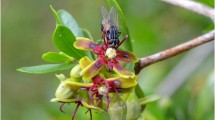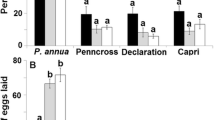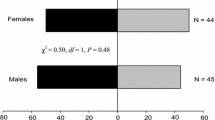Abstract
The behavioural responses of adult female western flower thrips, Frankliniella occidentalis (Pergande) to volatiles from meadow-sweet (Filipendula ulmaria), bay laurel (Laurus nobilis) and sage (Salvia officinalis) were investigated in laboratory bioassays. Volatiles collected by entrainment of a solvent extract of F. ulmaria were more attractive than was the original extract. Frankliniella occidentalis was also significantly attracted to volatiles from L. nobilis and S. officinalis. Analysis by gas chromatography and mass spectrometry identified 1,8-cineole (eucalyptol) as one of the main volatile components of all three plant species. In coupled gas chromatography-electroantennography studies with F. ulmaria, both 1,8-cineole and methyl salicylate elicited responses from F. occidentalis. Eucarvone was identified as the major component of F. ulmaria volatiles, but showed no electrophysiological activity. Behavioural responses of thrips to a range of concentrations of 1,8-cineole and methyl salicylate were tested using a modified Pettersson ’star’ olfactometer. 1,8-Cineole showed some attractant activity for the thrips at 0.01 mg, but methyl salicylate was repellent at all the concentrations tested.
Résumé
La réponse comportementale de femelles adultes de thrips (Frankliniella occidentalis) aux émissions volatiles de trois plantes aromatiques, la filipendule (Filipendula ulmaria), le laurier-sauce (Laurus nobilis) et la sauge (Salvia officinalis), a été étudiée dans des essais au laboratoire. Les produits volatils obtenus par collecte d’effluves d’un extrait par solvant de F. ulmaria se sont montrés plus attractifs que l’extrait original. Frankliniella occidentalis a aussi été attiré significativement par les émissions volatiles de L. nobilis et S. officinalis. Des analyses par Chromatographie en phase gazeuse et spectrométrie de masse ont permis d’identifier le 1,8-cineole (eucalyptol) comme l’un des composés volatils majeurs des trois espèces végétales. Dans des études par couplage Chromatographie en phase gazeuse-électroantennographie, avec un extrait de F. ulmaria, le 1,8-cineole et le methyl salicylate ont tous deux induit des réponses chez F. occidentalis. L’eucarvone a été identifié comme le composé majoritaire des émissions volatiles de F. ulmaria, mais n’a induit aucune activité électrophysiologique. Les réponses comportementales des thrips à une gamme de concentrations de 1,8-cineole et de methyl salicylate ont été évaluées dans un olfactomètre de Pettersson modifé. Le 1,8-cineole a induit une certaine attraction chez les thrips à la concentration de 0,01 mg, mais le methyl salicylate a été répulsif à toutes les concentrations testées.
Similar content being viewed by others
References
Adam K., Sivropoulou A., Kokkini S., Lanaras T. and Arsenakis M. (1998) Antifungal activities of Origanum vulgare subsp. hirtum, Mentha spicata, Lavandula angustifolia and Salvia fruticosa essential oils against human pathogenic fungi. J. Agric. Food Chem. 46, 1739–1745.
Agelopoulos N. G., Birkett M.A., Hick A. J., Hooper A. M., Pickett J. A., Pow E.M., Smart L. E., Smiley D.W.M., Wadhams L. J. and Woodcock C. M. (1999a) Exploiting semiochemicals in insect control. Pestic. Sci. 55, 225–235.
Agelopoulos N. G., Hooper A. M., Maniar S. P., Pickett J. A. and Wadhams L. J. (1999b) A novel approach for isolation of volatile chemicals released by individual leaves of a plant in situ. J. Chem. Ecol. 25, 1411–1425.
Blight M. M. (1990) Techniques for isolation and characterization of volatile semiochemicals of phytophagous insects, pp. 281–288. In Chromatography and Isolation of Insect Hormones and Pheromones (Edited by A. R. McCaffery and I. D. Wilson). Plenum Press, New York.
Brødsgaard H. F. (1994) Insecticide resistance in European and African strains of western flower thrips (Thysanoptera: Thripidae). J. Econ. Entomol. 87, 1141–1146.
Brunke E.-J., Hammerschmidt F.-J. and Schmaus G. (1993) Flower scent of some traditional medicinal plants. ACS Symposium Series 525, 282–296.
Burov V. N., Selitskaya O. G., Shamshev I. V. and Chermenskaya T.D. (2001) Attractants of plant origin to western flower thrips (Thysanoptera: Thripidae): Results of laboratory bioassays. Agrie. Chem. (in press).
Doederlein T. A. and Sites R. W. (1993) Host plant preferences of Frankliniella occidentalis and Thrips tabaci (Thysanoptera: Thripidae) for onions and associated weeds on the southern high plains. J. Econ. Entomol. 86, 1706–1713.
Ivanova G. and Velikanj V. (1995) The problems of thrips in protected ground of North-Western Russia. Arch. Phytopath. Planz. 30, 153–163.
Kirk W. D. J. (1985a) Effect of some floral scents on host finding by thrips (Insecta: Thysanoptera). J. Chem. Ecol. 11, 35–43.
Kirk W D. J. (1985b) Aggregation and mating of thrips in flowers of Calystegia sepium. Ecol. Entomol. 10, 433–440.
Kirk W. D. J. (1996) Thrips. Richmond Publishing Co. Ltd., Slough. 70 pp.
Kohidai L., Lemberkovics E. and Csabe G. (1995) Molecule dependent chemotactic responses of Tetrahymena pyriformis elicted by volatile oils. Acta Protozool. 34, 181–185.
Manjunatha M., Pickett J. A., Wadhams L. J. and Woodcock C. M. (1998) Response of western flower thrips, Frankliniella occidentalis, and its predator Amblyseius cucumeris to chrysanthemum volatiles in olfacto leter and greenhouse trials. Insect Sci. Applic. 18, 139–144.
Muller-Riebau F., Berger B. and Yegen O. (1995) Chemical composition and fungitoxic properties to phytopathogenic fungi of essential oils of selected aromatic plants growing wild in Turkey. J. Agrie. Food Chem. 43, 2262–2266.
Nazzi F. (1995) OLFA 1.0: A computer program for collecting and analysing behavioural data with the four-way olfactometer. Exeter Software. ISBN 0-925031-26-7.
Pettersson J. (1970) An aphid sex attractant. 1. Biological studies. Entomol. Scand. 1, 63–73.
Pow E.M., Bennison J.A., Birkett M.A., Luszniak M.J., Manjunatha M., Pickett J.A., Segers I.S., Wadhams L. J., Wardlow L. R. and Woodcock C. M. (1999) Behavioural responses of western flower thrips (Frankliniella occidentalis) to host plant volatiles, pp. 121–128. In Proceedings of the Sixth International Symposium on Thysanoptera, Antalya, Turkey, April 27-May 1 (Edited by G. Vierbergen and I. Tunc). Akendiz University, Antalya.
Pow E. M., Hooper A. M., Luszniak M. C, Pickett J. A. and Bennison J. A. (1998) Novel strategies for improving biological control of western flower thrips on protected ornamentals—attraction of WFT to verbena plants. The 1998 Brighton Conference - Pests and Diseases 5B-5, pp. 417–422.
Tucker A. O., Maciarello M. J. and Hill M. (1992) Litsea glaucescens Humb, Bonpl. & Kunth var. glaucescens (Lauraceae): A Mexican bay. Econ. Bot. 46, 21–24.
Valle M. G., Nano G. M. and Tira S. (1988) The essential oil oí Filipendula ulmaria. Planta Medica 2, 181–182.
Author information
Authors and Affiliations
Corresponding author
Rights and permissions
About this article
Cite this article
Chermenskaya, T.D., Burov, V.N., Maniar, S.P. et al. Behavioural Responses of Western Flower Thrips, Frankliniella occidentalis (Pergande), to Volatiles from Three Aromatic Plants. Int J Trop Insect Sci 21, 67–72 (2001). https://doi.org/10.1017/S1742758400020063
Accepted:
Published:
Issue Date:
DOI: https://doi.org/10.1017/S1742758400020063
Key Words
- thrips
- Frankliniella occidentalis
- volatiles
- Filipendula ulmaria
- Laurus nobilis
- Salvia officinalis
- attractant
- repellent
- electroantennogram
- 1,8-cineole
- methyl salicylate
- eucarvone




